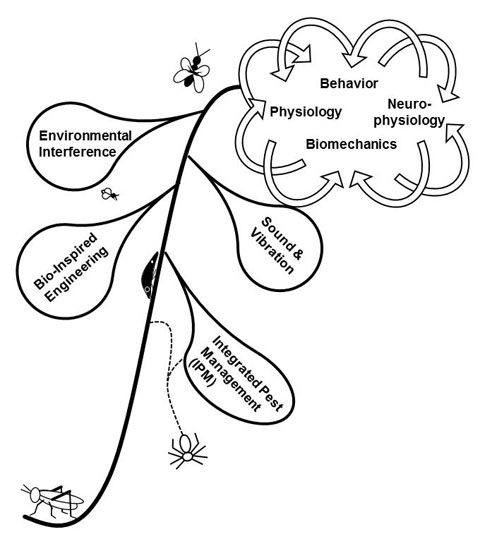Research Interests
Environmental Interference * Animal Communication * Hearing * Vibration
Communication does not happen in isolation. Not only does communication require other animals (a sender and receiver) but it also happens…somewhere!
…and that somewhere may influence what goes on. For example, if you are catching up with a good friend in a quiet park or at a restaurant or a sporting event, your topics will likely change as well as your voice level. Animals are the same. My research has found they are more reluctant to call if a predator is around (e.g. wolf spiders, Gordon and Uetz, 2012) or more “chatty” if there are other signaling animals around (e.g. glassy-winged sharpshooter, Gordon et al 2017). Spiders will even use more visual signals if they are on a substrate that does not transmit their vibrational signal (Gordon and Uetz 2011). My work has explored the communication between animals, during sex (Gordon and Krugner, 2021 in press).
Overall, one common thread of my work is communication and how differences in the microenvironment may alter behavior or signaling. What do I mean by microenvironment? Good concept to clarify. For some animals it means how their habitat may change in a short time period—such as if they are standing on a vibrating leaf or a sound dampening rock (Gordon and Uetz 2011) or perhaps if temperature is a factor in their hearing reception (Eberhard, Gordon, Windmill, Ronacher 2014). Many small or large factors may affect communication in a form of environmental interference. Some of my research aims to not just study natural interference but see how I can create this interference as a means to disrupt communication and therefore reduce the population of an agricultural pest—in a pesticide free method (Krugner and Gordon, 2018). We even examined how the vibrational signals travel on the branch (Gordon et al, 2019).
The root of my research can also be related to how much plasticity is there in animal signaling. That is, how much do animals change to suit their current needs, in regards to communication. Some animals have evolved the capacity to change and others have not. Therefore some of my research looks at basic communication patterns.
Similarly, understanding the HOW of communication is important. What I mean is, how does an ear work? What affects vibrations of the signals as they travel or received. From this idea we can learn a lot about mechanics that may be translatable to the engineering world. If an insect can hear with a 1mm sized ear, shouldn’t we be able to mimic that with our microphones?
I enjoy collaborative work across disciplines answering some of these questions. Working with engineers is exciting. Engineers and biologists view problems very differently but can come together to create and implement great ideas.
Environmental Interference * Animal Communication * Hearing * Vibration

General Research Interests
Insects and arthropods rule our natural world. In some cases we consider them pests or, conversely, in many cases beneficial animals. Learning about insect biology may benefit engineering, the medical field, or agricultural needs. My research focuses on animal communication and its plasticity due to environmental conditions. Specifically, I have focused on sound and vibrational signaling.
I approach my research from several angles interweaving fields such as animal physiology, behavior, neurobiology, biomechanics, evolution and genetics to understand how animals are enabled to survive in their niche.
My research addresses several broad questions:
- What environmental factors influence animal communication?
- How can an animal adjust its signaling to best fit the local conditions?
- What are the physiological flexibilities and constraints of an animal’s sensory biology?
- What evolutionary conditions have driven different and convergent hearing and vibration sensing systems?
- How can alternative methods (e.g., vibrational interference) control arthropods?
- What can engineers learn from insects to create better sensors, bio-engineering mimicry?
Animal communication is a dynamic process influenced by elements of the environment. I have studied some of the variations in the environment that may affect communication such as substrate for vibrational signaling, temperature during signaling, and neighbors—predators, competitors, or mates–that are nearby during signaling. In addition, I have studied intrinsic physiological factors affecting hearing such as differences in locusts phase (based on epigenetics) and their age.
By linking animals with their environment, I hope to tease apart the factors that shape animal communication. As insects have evolved hearing at least 19 independent times, each instance may inform about novel mechanisms and behaviors. By combining behavior, biomechanics, and neurophysiology I use integrative methods to answer my questions. My main work, thus far, spans leaf hoppers, moths, locusts, cicadas, wolf spiders, and parasitic wasps. I choose the animal that best suits my research questions and so prefer to adapt animal choice accordingly.
